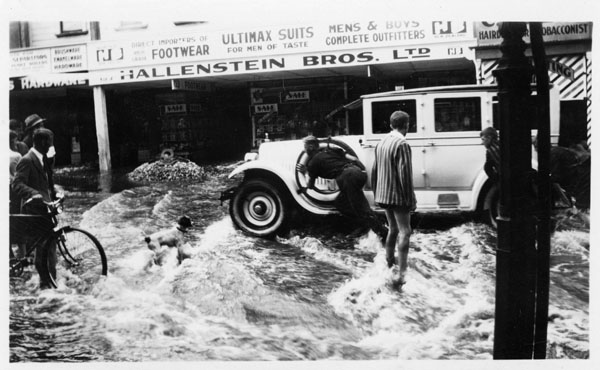

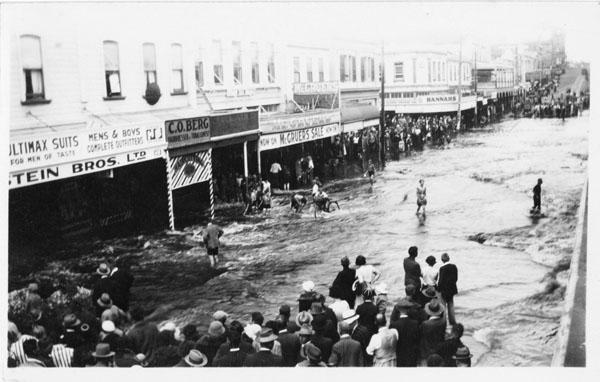
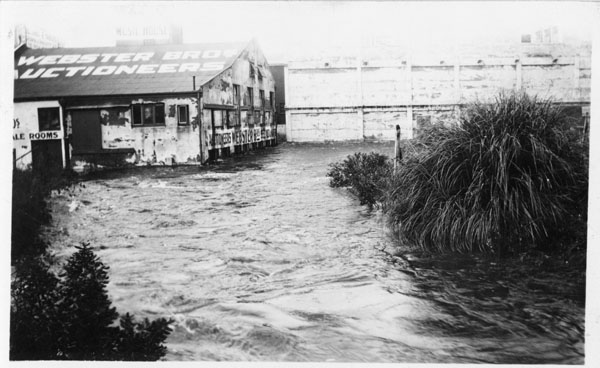
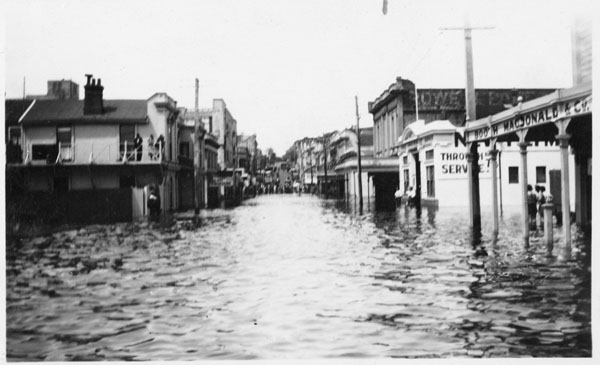
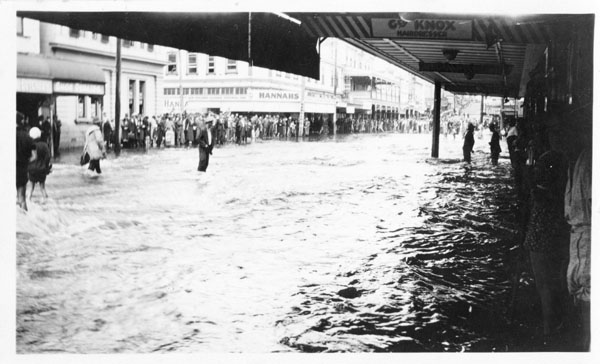
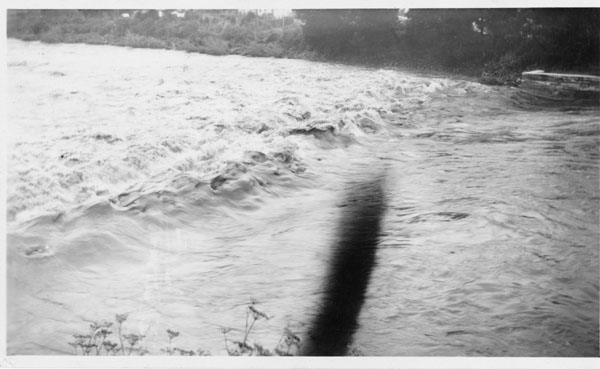
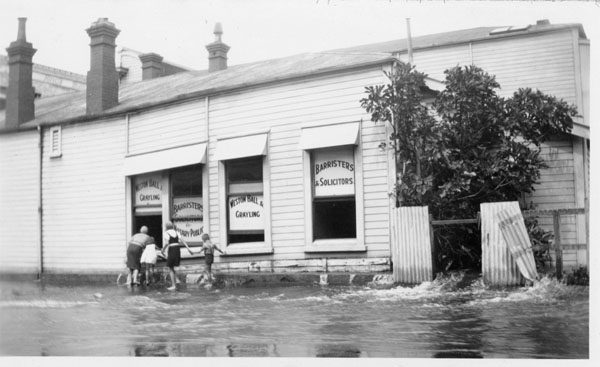
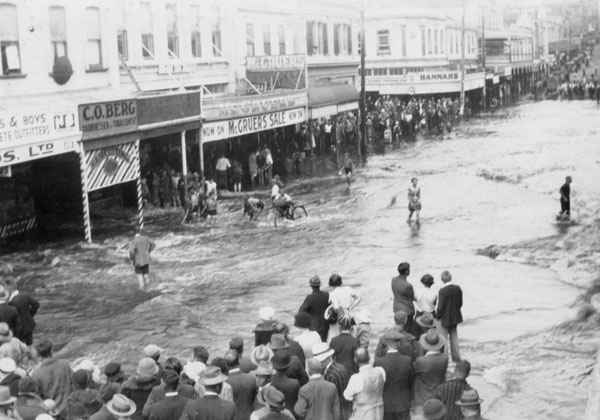
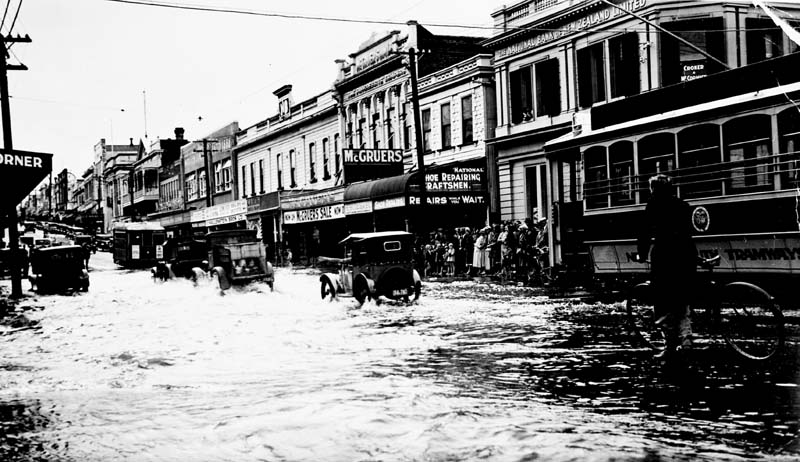
The headlines of 23 February 1935 said it all: “Wall of Water, Extensive Flooding, Bridges Collapse, Cattle Washed Away...”
The weather bureau had forecast sunshine with the odd shower or two - so no-one was expecting the deluge that appeared. Taranaki had been in drought, so farmers were praying for rain… and they got what they wanted. Rain began to fall on the evening of 20 February 1935, and didn't stop. It pelted down, with 18 centimetres falling in 24 hours.
By the next morning there was a problem. Rivers and streams had risen above their banks, bridges had been swept away, roads, railways and farmland were under water and stock had drowned.
In downtown New Plymouth the over-laden gutters and storm drains struggled to cope with the onslaught of water. Rivers burst their banks and flooded back yards. Then the worst hit.
Beneath the streets the raging Huatoki River met the over-laden Mangaotuku Stream and a rising spring tide, and had nowhere to go. Water began backing up before forcing its way into the back of buildings, spurting out the doors and windows of the shops on lower Devon Street.
Soon central New Plymouth from Egmont Street to Currie Street was up to two metres under water. The Kings Building was worst hit - the basement was under three metres of water. The flood area extended from central Devon Street down Brougham Street to the railway shunting yards.
Business owners had no warning and were unable to move their stock to safety. Merchandise was swept out into the street to be carried along with the water out to sea in a giant jumble. "Cartons of cigarettes and bottles of spirits from Devine and Co's Egmont Street warehouse swirled away down King and Ariki Streets, mixed up with car tyres from Dominion Motors, cues from the AMP Billiard Salon and papers from the offices of Standish, Anderson and Brokenshire. These items of flotsam met up in Brougham Street with a similar tide - lengths of fabric from McGruer's, tins of paint from Tingey's, masses of seed from Gilbert's Seed Merchant and books from Therkelson's Second Hand Shop" wrote Murray Moorhead in Tales of Old North Taranaki.
Beer barrels floated off down the street, labels on wine bottles washed off, clothing on racks was sodden and silt laden. Sections of the footpath rose and split apart, geysers of water gushed up through the cracks.
The most dramatic damage was sustained by the office of Weston, Ball and Grayling, barristers and solicitors, on the corner of Brougham and King Streets. The force of the water pushed the building upward nearly a metre, breaking it in two. Floodwaters rushed through the gap, taking whatever was in its pathway. Furniture, carpets and papers floated off downstream. Other businesses had doors and windows blown out and floors lifted. Shop assistants, some in gumboots, some in bathing togs, worked in the swirling water to salvage stock.
Further out in the city the Paritūtū Bowling Club greens were ruined as the Mangaotuku Stream burst its banks. Hundreds of properties along the stream were damaged as the water swirled up to three metres high. Residents were woken by water lapping at their bedsides, others rushed to help their elderly neighbours and put furniture above the waterline. Footpaths in Belt Road were buckled and residents in Weymouth, Aubrey, Gaine and Mt Edgcombe Streets were forced to flee as the water invaded their homes.
Tales of heroics and near misses abounded. A three-month old puppy saved a woman from drowning - or at least a good soaking - when it howled by her bedside. The woman awoke to find the puppy sitting in a pool of rapidly rising water. The house was soon submerged - furniture and appliances floating forlornly around the living room.
Five cows were rescued after being washed away down the raging Waiwhakaiho River. The cows were lassoed by passers-by as they floated under the bridge at Fitzroy. Apparently none the worse for the experience, the cows spent the night at the show grounds before being returned to their owner.
The most amazing escape of the flood occurred at the Waiongana Bridge on the main road north. The approach to the bridge collapsed, hurling a car and its two occupants five metres down into the raging stream. Both men survived the midnight dunking, suffering only scratches and shock. The state of the car was unknown ‘it still being submerged in water’ reported the Taranaki Herald.
Some people could see the humorous side of the flooding. A surf lifesaving carnival was being held in the town. Members of Wellington's Lyall Bay club were staying at the Royal Hotel, which flooded with just over a metre of water. "The situation was too much for their sense of humour, and the party, producing swimming togs, held a diving competition from the main staircase of the hotel" wrote the Taranaki Herald.
Other life savers held races around the flooded Brougham, King, Egmont and Ariki Streets block while a few conducted ‘thrilling 'rescues' of the fairer sex in the middle of Devon Street. Later the team dived into the churning waters to retrieve cardboard boxes that bobbed merrily downstream’.
Children wagged school and chased each other through the flooded streets, while their parents headed to the centre of town to see the damage.
Store owners tried to make the most of the deluge and minimise the losses which the flood had caused. By mid-morning one draper's window bore the notice, "Flood sale within. Goods are sold as they are taken from the water. First in first served!"
Amateur photographers took the opportunity of a lifetime and waters to get decent snaps. Photographers leaned out of windows, stood on verandas and braved the flood waters to get the perfect shot.
"Daily News staff shared a big laugh too" reported Moorehead. "Members of the staff had just returned to Powderham Street level after having lost their early morning battle to save their firm's cars and stocks of newsprint from being submerged, found themselves being lambasted by a nearby resident who had come to complain that his newspaper was damp!"
Around the district railway and traffic bridges were washed away or damaged, cutting off the district. The harassed farming community woke up to find kilometres of fencing torn down, and paddocks gouged out by raging streams. Road slips cut off many communities, and telephone lines were down. Schools were closed as students couldn't get to class through the flood waters.
As the waters receded the clean-up began. New Plymouth's city centre resembled a bazaar as shop owners hosed down racks of clothing, stacking up furniture and merchandise to clean and dry in the watery sunlight on the pavement outside. Silt and debris covered everything. Some shop owners didn't have to worry about a clean-up - their shops had been gutted by the rushing waters, leaving bare floors. Sales abounded as shops tried to get rid of flood soiled goods. Fears were that insurance wouldn't pay out - the flood had after all been an ‘act of God’.
It had been one of the most disastrous floods in the history of New Plymouth with over £20,000 of damage to stock in the business area of New Plymouth alone. In rural areas roads received over £25,000 of damage. Inglewood had received over 25 centimetres of rain and Dawson Falls a whopping 48.5 centimetres.
Moorhead, M. (1991). Tales of old North Taranaki. New Plymouth: Taranaki Branch, NZ Founders Society.
Please do not reproduce these images without permission from Puke Ariki.
Contact us for more information or you can order images online here.